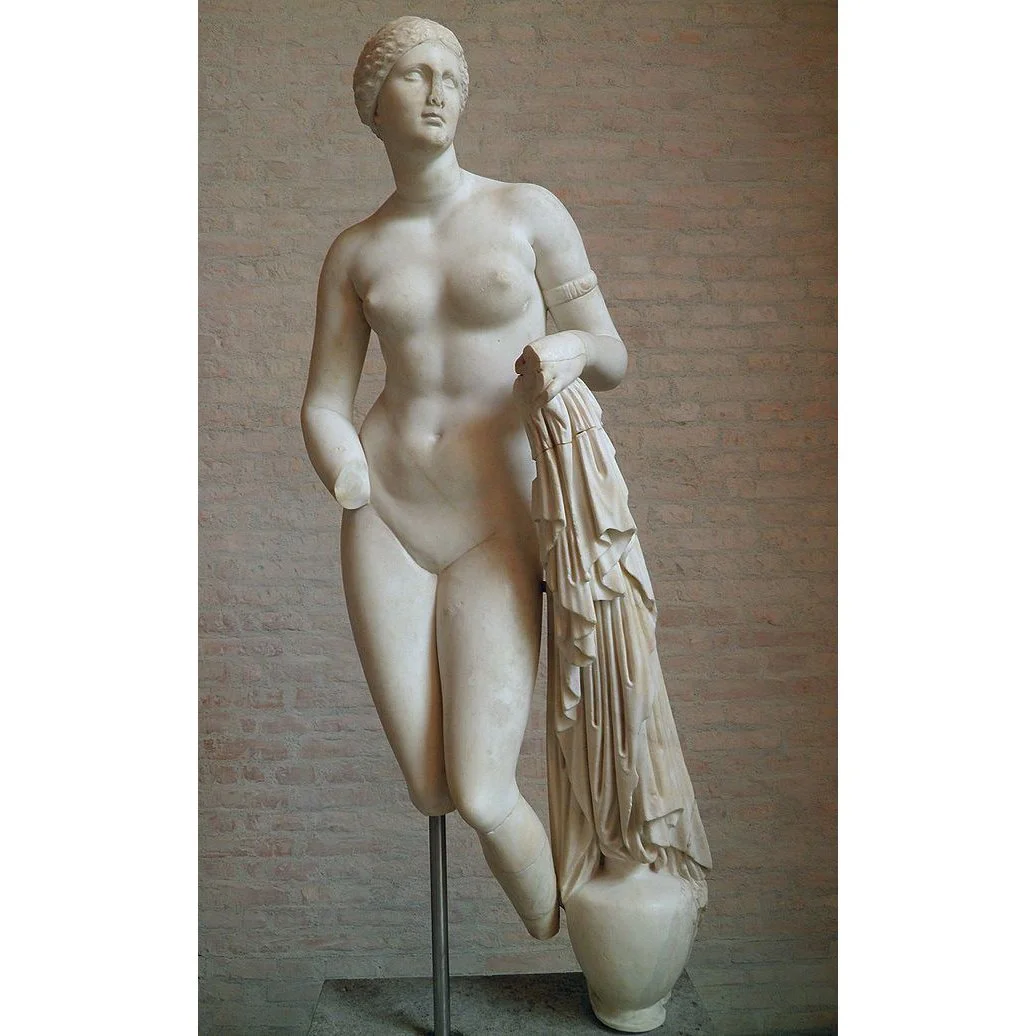 Image 1 of 1
Image 1 of 1


Online Talk · The Butt that Launched a Thousand Ships: The Aphrodite of Knidos and the Very Late Beginnings of the Female Nude in Ancient Greek Art with Art Historian Brenda Edgar
7pm ET (NYC time)
Monday, February 2, 2026
PLEASE NOTE: A link to a recording of this talk will be sent out to ticket holders after its conclusion. It will also be archived for our Patreon members. Become a Member HERE.
Ticketholders: A Zoom invite is sent out two hours before the event to the email used at checkout. Please check your spam folder and if not received, email hello@morbidanayomy.org. A temporary streaming link will be emailed after the event concludes.
Celebrate St Valentine’s Day with everyone’s favorite Goddess of Love, the Greek Aphrodite (known to the Romans as Venus). Although in the myths of Ancient Greece she was famed for her beautiful body, in its art she was clothed, as were all other female subjects in Greek sculpture. There was no room for feminine appeal in art, because the nude male body was so idolized, it flooded the visual landscape.
That is, until Praxiteles made his masterpiece: the first fully-nude life-size sculpture of a female body since the dawn of Greek civilization. In the waning years of the Classical period, the Greeks finally learned that women are beautiful. In this vividly illustrated lecture, we’ll get to know the fascinating backstory of this milestone in the History of Art, Culture, and Gender.
But that’s only the beginning of her story: we’ll also learn how the Aphrodite of Knidos would become world-famous as the most exciting Divine Sex Symbol in the ancient world, known especially for her beautiful backside.
Brenda Edgar is an art historian and yoga instructor in Louisville, KY. Her art history research interests include relics, reliquaries, and all things Roman Catholic; medieval medical manuscripts and depictions of disease in medieval art; and the historical role of altered states of consciousness in the creation of art.
Her free monthly public talk series, “Art History Illustrated,” is presented at the Cultural Arts Center in New Albany, Indiana; she also offers regular virtual classes through Morbid Anatomy, and teaches for Indiana University. In addition, Brenda is a certified yoga instructor with a robust teaching schedule. She lives in Louisville, KY with her two senior rescue dogs.
Image: Aphrodite of Knidos, Roman copy from the end of 1st century BC of a 4th century BC Greek original by Praxiteles, Glyptothek Munich (17245185062), Carole Raddato on Wikimedia
7pm ET (NYC time)
Monday, February 2, 2026
PLEASE NOTE: A link to a recording of this talk will be sent out to ticket holders after its conclusion. It will also be archived for our Patreon members. Become a Member HERE.
Ticketholders: A Zoom invite is sent out two hours before the event to the email used at checkout. Please check your spam folder and if not received, email hello@morbidanayomy.org. A temporary streaming link will be emailed after the event concludes.
Celebrate St Valentine’s Day with everyone’s favorite Goddess of Love, the Greek Aphrodite (known to the Romans as Venus). Although in the myths of Ancient Greece she was famed for her beautiful body, in its art she was clothed, as were all other female subjects in Greek sculpture. There was no room for feminine appeal in art, because the nude male body was so idolized, it flooded the visual landscape.
That is, until Praxiteles made his masterpiece: the first fully-nude life-size sculpture of a female body since the dawn of Greek civilization. In the waning years of the Classical period, the Greeks finally learned that women are beautiful. In this vividly illustrated lecture, we’ll get to know the fascinating backstory of this milestone in the History of Art, Culture, and Gender.
But that’s only the beginning of her story: we’ll also learn how the Aphrodite of Knidos would become world-famous as the most exciting Divine Sex Symbol in the ancient world, known especially for her beautiful backside.
Brenda Edgar is an art historian and yoga instructor in Louisville, KY. Her art history research interests include relics, reliquaries, and all things Roman Catholic; medieval medical manuscripts and depictions of disease in medieval art; and the historical role of altered states of consciousness in the creation of art.
Her free monthly public talk series, “Art History Illustrated,” is presented at the Cultural Arts Center in New Albany, Indiana; she also offers regular virtual classes through Morbid Anatomy, and teaches for Indiana University. In addition, Brenda is a certified yoga instructor with a robust teaching schedule. She lives in Louisville, KY with her two senior rescue dogs.
Image: Aphrodite of Knidos, Roman copy from the end of 1st century BC of a 4th century BC Greek original by Praxiteles, Glyptothek Munich (17245185062), Carole Raddato on Wikimedia
